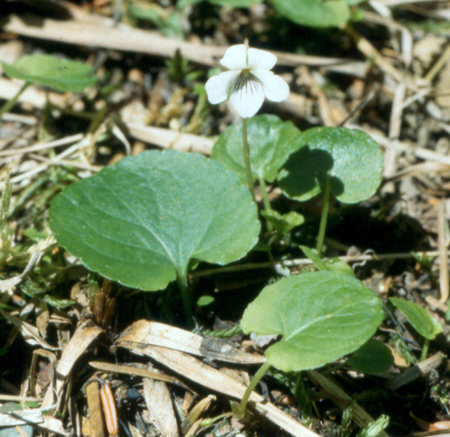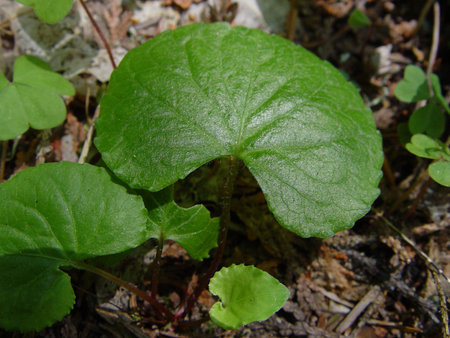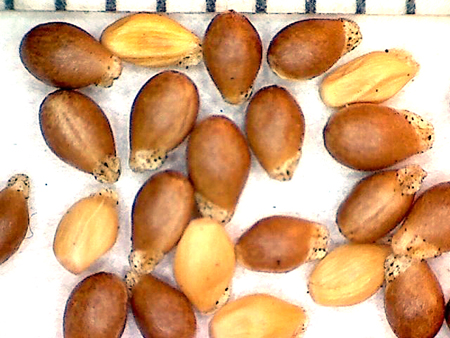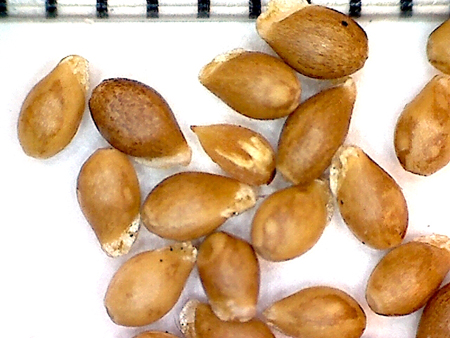Viola renifolia A.Gray
Common names:
Kidney-leaved Violet
Synonyms:
Viola renifolia A.Gray, Proc. Amer. Acad. Arts 8: 288. 1873; Viola blanda Willd. var. renifolia (A.Gray) A.Gray, Bot. Gaz. 11: 255. 1886. TYPE: "This Violet was first brought to my notice by Miss Shattuck of Mount Holyoke Seminary, who collected it at, or received it from, "East Elba, New York." Later Mr. Henry Gillman sent it from Ontonagon, Lake Superior; and now I have fresh specimens and the living plant from Mr. Frank A. Sherman, of Hanover, New Hampshire. Also specimens from the colder parts of Oneida Co., New York, from Professor Paine." [Gray cited four collections but did not specify one as the type. The following syntypes were found at GH or NY, or through a search of the JSTOR Global Plants database: 1) USA, New York, East Elba, Miss Shattuck s.n. (GH00067151!) ; 2) USA, Michigan, Ontonagon, Lake Superior, H. Gillman s.n. (GH00067152!; isosyntype: NY00097582!); 3) USA, New Hampshire, Hanover, F. A. Sherman s.n. (GH00067153!; isosyntypes: K000370203!, MO3723936!); 4) USA, New York, Oneida County, Professor [J. A.] Paine s.n. (GH00067154!). At GH, collections 1, 2 and 3 were on one sheet and 4 was on a separate sheet. Must select a lectotype.]
Viola renifolia A.Gray var. brainerdii (Greene) Fernald, Rhodora 14: 88. 1912; Viola brainerdii Greene, Pittonia 5: 89. 1902
Viola mistassinica Greene, Pittonia 4: 5. 1899
Description:
Acaulescent rosulate perennials from slender rhizome, ≤ 10 cm tall; foliage and peduncles gray-green, petioles and peduncles often red-tinged, upper surface of leaf blade darker than lower and shiny, all glabrous, or peduncles and/or petioles densely hirsute and/or one or both surfaces of leaf blades appressed-tomentose; stipules free, glandular-fimbriate; leaves widely spreading or more often prostrate on the substrate, especially during fruit, leaf blades undivided, largest ≤ 62 × 77 mm, rarely broadly ovate but commonly (sub)orbicular to broadly reniform, base deeply cordate, margins low-serrate, eciliate or ciliate, apex broadly obtuse to truncate, occasionally apiculate; chasmogamous peduncle held above the leaves, glabrous or hirsute if foliage is hirsute; chasmogamous flower ≤ 12 mm; calyx glabrous, eciliate or long-ciliate; lowest sepals lanceolate to ovate-lanceolate, obtuse; auricles short and entire, not elongating in fruit; corolla white, throat greenish-white; spur short-globose; all petals glabrous or lateral petals occasionally with sparse beard of slightly clavate hairs; chasmogamous capsule green; cleistogamous flowers produced after chasmogamous, peduncle initially prostrate but arching upward just before capsule dehiscence, much shorter than petioles; cleistogamous capsule 5–10 mm, green drying tan with purple spots or blotches, glabrous; seeds 1.7–2.4 × 1.2–1.4 mm, lighter medium to medium orange-brown to brown, unspotted; 2n=24.
Similar species:
This species is most similar to other Stolonosae violets with leaf blades nearly as broad as to broader than long. It differs from all Stolonosae in our region in the total absence of stolons, and from most species except V. blanda in its widely spreading to prostrate leaves. In chasmogamous flower it is obviously different from V. palustris and V. suecica in its white corolla. It can be distinguished from V. minuscula in its petioles and leaf laminas being strictly glabrous, densely hirsute, or one or both laminas hirsute, its proportionally broader leaf blades with noticeably serrate margins, heavily purple spotted or blotched cleistogamous capsule on a short prostrate peduncle, and orange-brown to brown seeds. It is most similar to and often confused with V. incognita; if its lack of a horizontal stoloniform rhizome and stolons, and widely spreading to prostrate leaves are ignored, it can be separated by the strictly glabrous or wholly densely hirsute foliage or one or both leaf blade surfaces densely hirsute, its orbicular to reniform leaf blades, glabrous or occasionally sparsely bearded lateral petals, and slightly larger seeds.
Ecology:
Dry organic-rich often sandy or rocky soil, or ledges in dry or dry-mesic forests, somewhat of a calciphile and often on limestone.
Distribution:
Predominately boreal and alpine, NL and NU to AK, south to RI, PA, MI, IA, CO and WA.
Rarity:
State listed in CT, IA, and PA.
Phenology:
Chasmogamous flower April–July, chasmogamous fruit June–August, cleistogamous fruit June–September.
Affinities:
This species belongs to the Acaulescent White Violet lineage, sect. Plagiostigma Godron, subsect. Stolonosae (Kupffer.) Kupffer.
Hybrids:
Hybridizes with V. incognita (Ballard 1995). Hybrids with V. blanda and V. minuscula are possible and should be sought in the zone of sympatry. The reproductive behavior of the hybrids is not reported, but the interploidal hybrids with V. blanda or V. incognita would presumably be sterile, failing to reproduce by chasmogamy or cleistogamy. Studies are needed to evaluate these predictions.
Comments:
Brainerd (1921b), Brainerd Baird (1942), Fernald (1950), Henry (1953a), Russell (1955c), Alexander (1963), Russell (1965), Scoggan (1978), Gleason and Cronquist (1991), Ballard (1995, 2000), Haines et al. (2011), Voss and Reznicek (2012), and Little and McKinney (2015) accepted this distinctive species. Brainerd, Brainerd Baird, Fernald, Alexander, and Scoggan also recognized var. brainerdii for plants with both surfaces of leaf blades glabrate to wholly glabrous. Later taxonomists realized that variation in foliage indument occurred within populations and did not correlate with any other morphological feature. Recognition of infraspecific taxa on the basis of indument was trivial and fruitless, and infraspecific taxa in the present species were abandoned. This species is distinctive in being the only one of the Stolonosae which never produces surficial stolons or stoloniform rhizomes. It is easy to identify in chasmogamous flower by its strongly reniform or occasionally orbicular leaf blades, upper leaf blade surface commonly strictly glabrous and shiny or one or both surfaces densely tomentose, margins distinctly low-serrate, purple-spotted or -blotched cleistogamous capsule on prostrate peduncle, and brown seeds. The leaves, especially in summer fruit, commonly lie flat on the substrate. The drier forest microhabitat, especially on calcareous soils or in rock crevices, is also distinctive. Specimens in boreal or alpine regions bearing stolons invariably show other signs of hybridization, usually with V. incognita, such as variably pubescent foliage, well bearded lateral petals or infertile cleistogamous capsules. In a molecular phylogenetic study of North American and Hawaiian Viola taxa and lineages, Marcussen et al. (2012) demonstrated that V. renifolia and V. minuscula (as V. pallens) were tetraploid parents of the allo-octoploid V. blanda and V. incognita. Given several shared morphological similarities in foliage, flowers and seeds between the present species and its allopolyploid derivative V. incognita, it is not surprising that the two species have frequently been confused.
Literature Cited:
Alexander, E. J. 1963. Violaceae. In Gleason, H. A., The new Britton and Brown illustrated flora of the northeastern United States and adjacent Canada. Hafner Publishing Co., Inc., New York, NY. 552-567.
Ballard Jr., H. E. 1995 ["1994"]. Violets of Michigan. Michigan Botanist 33: 131-199.
Ballard Jr., H. E. 2000. Violaceae. In Rhoads, A. (ed.). Flora of Pennsylvania. University of Pennsylvania Press, Philadelphia, PA. 700-710.
Brainerd, E. 1921b. Violets of North America. Vermont Agricultural Experiment Station Bulletin 224: 1-172.
Brainerd Baird, V. 1942. Wild violets of North America. University of California Press, Berkeley, CA.
Fernald, M. L. 1950. Violaceae. In Gray’s Manual of Botany, 8th ed. American Book Company, New York, NY. 1022-1042.
Gleason, H. A., and A. Cronquist. 1991. Violaceae. In Manual of vascular plants of northeastern United States and adjacent Canada, 2nd ed. New York Botanical Garden, Bronx, NY. 157-163.
Haines, A., E. Farnsworth, and G. Morrison. 2011. Violaceae. In Flora Novae Angliae. Yale University Press, New Haven, CT. 873-886.
Henry, L. K. 1953a. The Violaceae in western Pennsylvania. Castanea 18(2): 37-59.
Little, R. J., and L. E. McKinney. 2015. Violaceae. In Flora of North America: Cucurbitaceae to Droseraceae, 106. Oxford University Press, New York, NY.
Marcussen, T., K. S. Jakobsen, J. Danihelka, H. E. Ballard, K. Blaxland, A. K. Brysting, and B. Oxelman. 2012. Inferring species networks from gene trees in high-polyploid North American and Hawaiian violets (Viola, Violaceae). Systematic Biology 60: 1-20.
Russell, N. H. 1965. Violets (Viola) of the central and eastern United States: An introductory survey. Sida 2: 1-113.
Scoggan, H. J. 1978. Violaceae. In Flora of Canada, Part 3–Dicotyledoneae (Saururaceae to Violaceae). National Museums of Canada. Ottawa, Canada. 1103-1115.
Voss, E. G., and A. A. Reznicek. 2012. Violaceae. In Field manual of Michigan flora. The University of Michigan Press, Ann Arbor, MI. 913-922.

Chasmogamous flowering habit by Arthur Haines, "Go Botany" website, Native Plant Trust

Leaves by Donald Cameron, "Go Botany" website, Native Plant Trust

Seeds from herbarium specimen: CT, Litchfield, Cornwall, 2 Jul 1929, E. H. Eames 10938 (CBS028123)

Seeds from herbarium specimen: QC, 21 Jul 1971, L. Cinq-Mars & P. Masson 71-379 (OS394262)

Map by the Biota of North America Program